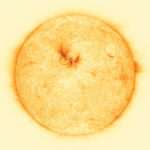
NASA’s Solar Dynamics Observatory (SDO) has observed the Sun continuously for over 10-years and collected 425 million high-resolution images of the star. All of these images consist of 20-million gigabytes of data, providing researchers with the data necessary for countless new discoveries about the workings of the Sun and how it influences the solar system.
SDO uses its high-tech instruments to capture an image of the Sun every 0.75 seconds,as the Atmospheric Imaging Assembly (AIA) alone takes photos every 12 seconds at 10 different wavelengths of light. This footage showcases photos taken at a wavelength of 17.1 nanometers, or to be more specific, an extreme ultraviolet wavelength that shows the Sun’s corona. You’re looking at one photo every hour to condense over a decade of the Sun into a mere 61-minutes.
- SUPERIOR OPTICS: The Celestron 70mm Travel Scope features high-quality, fully-coated glass optics, a potent 70mm objective lens, a lightweight frame, and a custom backpack to carry it all. Its quality is unmatched in its class and against competitors.
- POWERFUL EYEPIECES FOR UP-CLOSE VIEWING: Our telescope for astronomy beginners is equipped with two high-quality eyepieces (20mm and 10mm) that provide low- and high-power views of celestial objects at night and terrestrial objects during the day.
- LARGE 70MM OBJECTIVE LENS: Our refractor telescope is equipped with a large 70mm aperture objective lens that provides enhanced, brighter views compared to the 50mm model while adding very little additional weight. Setting up and using the Travel Scope is quick and easy.
While SDO has kept an unblinking eye pointed toward the Sun, there have been a few moments it missed. The dark frames in the video are caused by Earth or the Moon eclipsing SDO as they pass between the spacecraft and the Sun. A longer blackout in 2016 was caused by a temporary issue with the AIA instrument that was successfully resolved after a week. The images where the Sun is off-center were observed when SDO was calibrating its instruments,” said NASA.





